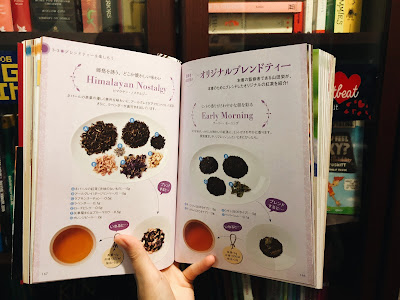I thought I’d switch things up by reviewing/summarising a book on tea called The Black Tea Bible. Like its name says, this all about tea. I first saw it in a bookshop, decided not to buy it, then regretted it so much I ordered the book from Amazon.
 |
| I just put some random teas with the book cause it looked lonely. |
Summary
Chapter 1 is on how to make black tea. The book goes into detail about the type of water needed, how long to boil, and provides step by step instructions on how to make various types of milk tea, such as straight, iced, royal milk tea, etc. They even have different instructions if you’re using a tea bag instead of loose leaf. Personally, I thought that the royal milk tea recipe is one that I’ll want to use, so here are the instructions:
1. Put fresh water (from the tap) into the pot and boil until bubbles that are roughly two to three cm in size start to appear. For two cups (300ml) of milk tea, use about 160ml of water.
2. Turn off the heat and add the tea leaves. The book recommends 6g of Assam or Uva [1] tea.
3. Add in the milk and turn the heat on low. You should use the same amount of milk as you did for water, so use 160ml.
4. Mix gently while continuing to heat the tea. You don’t want to overheat this, so turn off the heat once bubbles start appearing all around the surface.
5. Cover the pot with a lid and leave it for a while. The amount of time varies according to the type of tea, but you’ll want to leave it a little longer than for a straight tea.
6. Pour the tea through a strainer into a pot and TADA! Royal milk tea.
Chapter 2 is on tea and where it’s grown. This chapter has information on the climate and famous teas of various tea regions from China, India, to Indonesia and Japan, and even profiles various tea plantations. There’s also a column on the day in a life of a tea plantation manager which I thought was interesting.
Chapter 3 was about the various types of tea. I learnt that flavour teas are teas + dried fruits and other things, blend teas are various types of blended teas (like Assam + Darjeeling), and blend teas + fruits, etc are supposed to be called mixed teas but for simplicity’s sake the book called it blend teas too.
The section on flavour teas is really a selection of teas from a shop called Leafull, probably because someone there edited the book. The herb tea section was good, with clear instructions on how to make herb tea from scratch (they advocate buying small amounts frequently for freshness), and a list of various teas as well as their health benefits. The blend tea section had another selection of teas from Leafull, but also an original blend tea section:
These are blended teas suggested by the editor of the book and the interesting thing is that they give you the amount of teas needed to make them yourself! For example, the Early Morning tea on the right page consists of 3 grams Darjeeling (BOP type), 5 grams Uva (BOP type), 3 grams Assam (CTC type), and 0.1 grams peppermint. Each serving of this blend should use 4 grams of tea, 300 ml of water and you need to steep the tea for 3 minutes.
On the left page, the Himalayan Nostalgy on the left page consists of 5g of Nepalese tea, 6 grams of Earl Grey (Darjeeling base), 0.5g of Lapsang Souchong, 0.1g of Lavender, 0.5g of Rosepink, 0.5g of Blue Mallow, 2g of Orange Peel. Each serving for this blend is 5g, you’ll need 300ml of water, and you need to steep the tea for 5 minutes.
Chapter 4 was my favourite chapter because it’s about the different ways you can enjoy tea! There are tea recipes (including tea cocktails), recipes for cooking with tea, as long as information on tea parties and afternoon tea. Some of the tea party information feels a bit dated, such as sending invitation cards (this is after telling us that tea parties at home can be casual), and to avoid topics like politics during the conversation, or it could just be a cultural gap.
The last chapter, Chapter 5, contains information on various tea brands, recommended teas for different occasions, and a brief history of tea (quite Euro-centric though they did put in the history of black tea in Japan). I was quite happy to see TWG mentioned here as a high-quality tea brand[2].
Thoughts
Overall, I’m really glad that I got this book because it’s jam-packed with information and this was what made me realise that I’m just a newbie to the world of tea. I’m probably not going to stop my super casual tea drinking habits, but I do want to try some of the recipes and brands! I just have to find the time and a weighing machine for the tea.
Notes
[1] Uva tea is tea from the Sri Lankan province of Uva. Interestingly, the Wikipedia entry for Uva tea is only available in Japanese.
[2] Sadly, 1872 Clipper tea was not mentioned.

